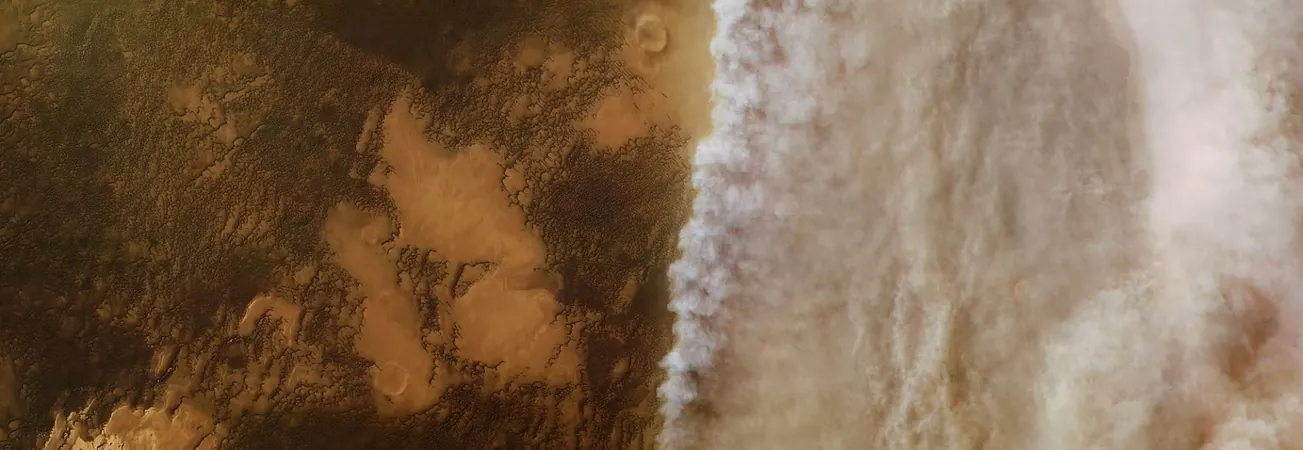
Unraveling the Mystery of Mars Dust Storms: A New Study Reveals Surprising Insights
2025-01-03
Author: Yu
Introduction
Mars has long captivated scientists and space enthusiasts alike, especially for its dramatic and extensive dust storms that occur annually during the Martian summer in the southern hemisphere. Every three Martian years—equivalent to roughly 5.5 Earth years—some of these storms become so massive that they envelop the entire red planet for extended periods, sometimes lasting for several months.
These global dust storms pose considerable challenges to robotic missions by generating electrostatic charges that not only disrupt electronic systems but also cause dust accumulation on solar panels, compromising their ability to harvest power effectively.
New Study Findings
Until now, the precise triggers for these colossal storms remained a contentious topic among researchers. A groundbreaking new study from a team of planetary scientists at the University of Colorado Boulder has made significant strides in unraveling these mechanisms.
Their research suggests that relatively warm and sunny conditions can initiate the largest dust storms every few Martian years, which opens up new avenues for the potential forecasting of extreme weather events on Mars. This could prove crucial for planning future crewed missions to the planet.
Research Team
Led by graduate student Heshani Pieris and researcher Paul Hayne, whose expertise spans the Laboratory for Atmospheric and Space Physics (LASP) and the Department of Astrophysical and Planetary Sciences at CU Boulder, the study's findings were unveiled at the prestigious 2024 meeting of the American Geophysical Union in Washington, D.C.
Formation of Dust Storms
Dust storms on Mars often originate as smaller weather events in polar regions, typically in the latter half of the Martian year. These storms can rapidly expand towards the equator, covering vast areas—millions of square kilometers—in a matter of days.
Despite Mars’ thin atmosphere, which is only about 0.5% as dense as Earth's, the implications of these storms are profound. Past storms have disrupted operations of rovers such as Opportunity in 2018 and InSight last year, leading to their eventual loss.
Impact on Missions
"Dust storms have a profound impact not only on our rovers and landers but also pose a serious risk for future astronauts on Mars," Pieris explained in a recent release. "The dust is lightweight yet highly adhesive, affecting equipment and possibly injuring personnel." Hayne added, "While the wind pressure from these storms may not be strong enough to topple structures, the speed at which these dust grains can travel is alarming and can damage astronauts and their gear."
Research Approach
For their investigation, Pieris and Hayne concentrated on two specific weather patterns colloquially known as "A" and "C" storms, which recur annually on Mars. Utilizing data from the Mars Climate Sounder aboard NASA’s Mars Reconnaissance Orbiter over a span of 15 years (or eight Martian years), they identified periods of unusual temperature spikes that could have contributed to storm formation.
Their analysis revealed that approximately 68% of significant dust storms were preceded by a notable rise in surface temperatures, leading to increased dust events.
Conclusion
While this doesn't indisputably confirm that vaporous warmth alone incites dust storms, the findings strongly suggest that similar atmospheric dynamics found on Earth might also be at play on Mars. Much like hot summer days in dry regions on our planet, where heated air rises and precipitates storm formation, Pieris posits that, "Heating the Martian surface can cause the adjacent atmospheric layer to become buoyant, resulting in dust being lofted upwards."
As Pieris and Hayne pursue more contemporary observations to deepen their understanding of Martian weather patterns, their ongoing work could eventually lead to real-time predictions of Martian weather—an essential development for future explorations aimed at uncovering the mysteries of Mars and perhaps even establishing human presence.
Future of Martian Exploration
Could this research herald the dawn of a new era in Martian exploration? Keep your sights trained on the red planet as scientists continue to peel back the layers of its dusty veil!

 Brasil (PT)
Brasil (PT)
 Canada (EN)
Canada (EN)
 Chile (ES)
Chile (ES)
 Česko (CS)
Česko (CS)
 대한민국 (KO)
대한민국 (KO)
 España (ES)
España (ES)
 France (FR)
France (FR)
 Hong Kong (EN)
Hong Kong (EN)
 Italia (IT)
Italia (IT)
 日本 (JA)
日本 (JA)
 Magyarország (HU)
Magyarország (HU)
 Norge (NO)
Norge (NO)
 Polska (PL)
Polska (PL)
 Schweiz (DE)
Schweiz (DE)
 Singapore (EN)
Singapore (EN)
 Sverige (SV)
Sverige (SV)
 Suomi (FI)
Suomi (FI)
 Türkiye (TR)
Türkiye (TR)
 الإمارات العربية المتحدة (AR)
الإمارات العربية المتحدة (AR)